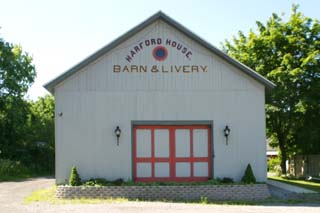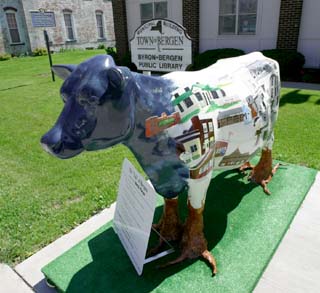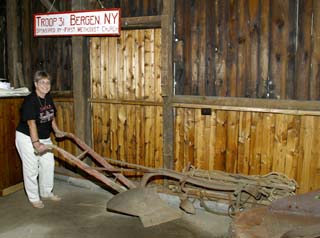
The Bergen Historical Society, a group interested in preserving the past for the future of Bergen, has undertaken another task in that quest. And in a community filled with history from its humble roots in 1801 –– when a road was hacked through the thick northwoods from LeRoy to Lake Ontario, to the boom it experienced when the railroad made its way through the region in 1836 – Bergen certainly has a myriad of history worth preserving. The old Harford House barn and livery is the latest piece of history the group is intent on preserving. “The barn is significant because we were looking for a place to house a museum exhibit and when we learned this barn was going to be demolished, the group said ‘let’s get involved, raise some money and save that barn,’ ” Peggy Denton, Town of Bergen historian said. Denton said the Harford House was “quite a mecca” in its day when people would come from all across the country to stay in the house. “We have a guest book from back in the era of the house’s operation,” she said. “It’s amazing how many people came through this area, especially when the trains starting running in the 1900s.” Traveling merchants used to arrive by train, room at the hotel, rent a horse and buggy and travel the countryside peddling their wares. Locals would come from North Bergen or Stone Church, leave their horse in the livery and take the train into Rochester to conduct their business. The barn, livery stable and carriage house were a vital part of the Harford House (now the Devonshire Apartments). When the Harford barn project is complete, Denton said it will be home to Bergen’s exhibits of pioneer life, historic artifacts and genealogy records. “We maintain quite a database for individuals looking to research their family history and we have helped bring some families together through their research,” she explained. “We’re also looking to use the barn as a meeting place where we can bring in historical speakers.” To date, the barn has been repainted in its original colors. “We found the name of the original colors imprinted on some of the barnwood so we are refurbishing it with as much historical accuracy as possible,” Denton said. Funding for the project continues to be a priority for the group. They are seeking $8,000 to complete the project which, when done, would provide a security system, reception desk, computer system and software for the archiving of historical artifacts. From the onset of the project, Denton said, countless volunteers have donated time and resources toward making the dream of the barn restoration a reality. Tax deductible donations are being accepted by the Bergen Historical Society and can be mailed to 13 South Lake Street, Bergen. The society will also be hosting a collectible and plant sale on August 7 at the Stone Church Presbyterian Church. For information contact Denton at 494-1456 or Village of Bergen historian Tally Almquist at 494-1675. The barn is located east of the Bergen Town Hall. |


